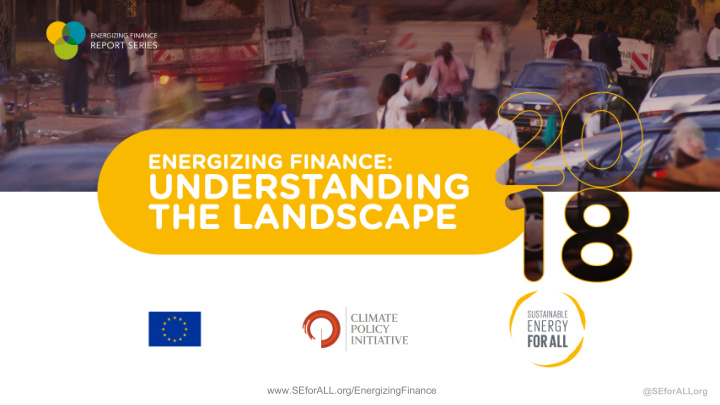



www.SEforALL.org/EnergizingFinance @SEforALLorg
USD 30.2 billion in financing for access to electricity tracked in 20 High-Impact Countries 2015-16 @SEforALLorg
USD 30 million in financing for clean cooking tracked in 20 HICs 2015-16 @SEforALLorg
Public and private sources of finance for electricity across the 20 HICs (%) @SEforALLorg
Finance for electricity access in the 20 HICs Percentage without access to electricity, total finance tracked in 2015-16 (USD billion) and % change from 2013-14 Source: Access figures based on World Bank Indicators. @SEforALLorg
Finance for clean cooking in the 20 HICs Percentage without access to clean cooking, total finance tracked 2015-16 (USD million) and % change from 2013-14 Source: Access figures based on World Bank Indicators. @SEforALLorg
Difference in electricity financing across the HICs between 2013-14 and 2015-16 (USD million, y-o-y change) Note: North Korea is not included in the chart due to negligible amounts tracked. @SEforALLorg
Source of finance for electricity across the HICs (USD billion) Note: Average over 2015-16. @SEforALLorg
Comparison between 2013-14 and 2015-16 of finance (USD million) for clean cooking Note: Average over 2015-16. No data was found for Afghanistan, China, Congo DR, Korea DPR, Myanmar, Philippines or Sudan. @SEforALLorg
Finance for electricity (USD billion) in HICs in 2015-16 @SEforALLorg
Finance for clean cooking (USD million) in HICs in 2015-16 @SEforALLorg
Estimated financial commitments for electricity by end user across the 20 HICs (USD billion) @SEforALLorg
Country recipients of international public finance by type (USD billion) Note: Average over 2015-16. @SEforALLorg
Finding a way forward for electricity • Target financing efforts in all HICs, not just a few • International public financial institutions need to maximize finance for development to fill continuing financing gaps and stimulate market development for private sector engagement, particularly in hard-to-reach markets. • Reverse the significant increase in finance for fossil fuel fired power generation, notably coal. Ø Policy makers need to prioritize non-coal fired power generation as part of their integrated energy planning and investment Ø Greater efforts for private capital to recognize the cost-competitive nature of RE generation. Ø Public and private financing should align lending policies and practices with Paris Agreement commitments in the countries in which they fund energy access projects and activity. • India demonstrates the market transformation that is possible when governments establish targets and implement policies to prioritize electricity access and RE. • Government leaders, especially in Sub-Saharan Africa HICs, need to learn from success and promote best practice. @SEforALLorg
Finding a way forward for clean cooking • Stronger emphasis is needed to create “big markets” rather than incremental solutions • Meeting SDG7 targets requires a paradigm shift in how the global community supports access to clean cooking • International community needs to take a refreshed, holistic approach to the issue – one that affects approximately 3 billion people globally • Government commitment, target setting and allocation of domestic budget (Indonesia example) with attention to moving big markets forward @SEforALLorg
www.SEforALL.org/EnergizingFinance @SEforALLorg
Recommend
More recommend